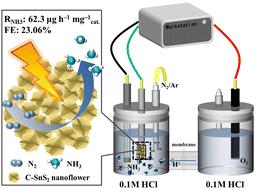当前位置:
X-MOL 学术
›
New J. Chem.
›
论文详情
Our official English website, www.x-mol.net, welcomes your
feedback! (Note: you will need to create a separate account there.)
Carbon-doped tin disulfide nanoflowers: a heteroatomic doping strategy for improving the electrocatalytic performance of nitrogen reduction to ammonia
New Journal of Chemistry ( IF 2.7 ) Pub Date : 2022-08-30 , DOI: 10.1039/d2nj02478k Jingyi Xu 1 , Xiaolong Xu 1 , Yu Du 2 , Dan Wu 1, 2 , Hongmin Ma 1, 2 , Xiang Ren 1, 2 , Yuyang Li 1 , Qin Wei 1, 2
New Journal of Chemistry ( IF 2.7 ) Pub Date : 2022-08-30 , DOI: 10.1039/d2nj02478k Jingyi Xu 1 , Xiaolong Xu 1 , Yu Du 2 , Dan Wu 1, 2 , Hongmin Ma 1, 2 , Xiang Ren 1, 2 , Yuyang Li 1 , Qin Wei 1, 2
Affiliation

|
As a new method of ammonia (NH3) synthesis, the electrocatalytic nitrogen reduction reaction (eNRR) has generated widespread attention. The tin-based catalysts represent a broad development prospect in the field of electrocatalysis, but their eNRR performances need to be improved. In this work, hydrophobic carbon-doped tin disulfide (C-SnS2) was fabricated for the first time and adopted as an advanced catalyst for the eNRR. The doped C may adsorb more N2 and significantly improve the conductivity, which will contribute synergistically to the performance of the eNRR. The C-SnS2 nanoflower catalyst achieved a satisfactory NH3 yield rate (62.3 μg h−1 mg−1cat.) and high Faraday efficiency (23.06%) at −0.2 V vs. RHE in acidic conditions (0.1 M HCl). This work may provide new methods for the further development of high activity eNRR catalysis.
中文翻译:

碳掺杂二硫化锡纳米花:提高氮还原成氨电催化性能的杂原子掺杂策略
电催化氮还原反应(eNRR)作为一种合成氨(NH 3 )的新方法引起了广泛关注。锡基催化剂在电催化领域具有广阔的发展前景,但其eNRR性能有待提高。在这项工作中,首次制造了疏水性碳掺杂二硫化锡(C-SnS 2 ),并将其用作eNRR的先进催化剂。掺杂的C可以吸附更多的N 2并显着提高电导率,这将对eNRR的性能产生协同作用。C-SnS 2纳米花催化剂获得了令人满意的NH 3产率(62.3 μg h -1 mg -1 cat.)和在酸性条件(0.1 M HCl)下-0.2 V与RHE 的高法拉第效率(23.06% )。这项工作可能为进一步开发高活性eNRR催化提供新的方法。
更新日期:2022-08-30
中文翻译:

碳掺杂二硫化锡纳米花:提高氮还原成氨电催化性能的杂原子掺杂策略
电催化氮还原反应(eNRR)作为一种合成氨(NH 3 )的新方法引起了广泛关注。锡基催化剂在电催化领域具有广阔的发展前景,但其eNRR性能有待提高。在这项工作中,首次制造了疏水性碳掺杂二硫化锡(C-SnS 2 ),并将其用作eNRR的先进催化剂。掺杂的C可以吸附更多的N 2并显着提高电导率,这将对eNRR的性能产生协同作用。C-SnS 2纳米花催化剂获得了令人满意的NH 3产率(62.3 μg h -1 mg -1 cat.)和在酸性条件(0.1 M HCl)下-0.2 V与RHE 的高法拉第效率(23.06% )。这项工作可能为进一步开发高活性eNRR催化提供新的方法。











































 京公网安备 11010802027423号
京公网安备 11010802027423号